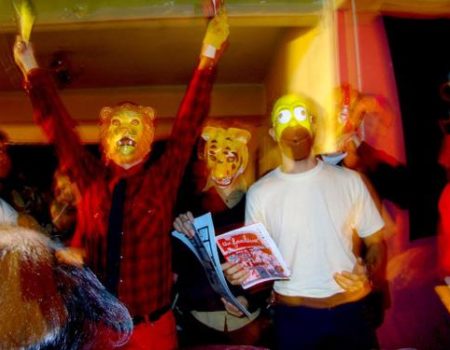By Pablo Turnes
Header Illustration: Mike Diana
WARNING: THIS NOTE CONTAINS GRAPHIC AND TEXTUAL CONTENT THAT CAN RESULT OFFENSIVE TO SENSITIVE PERSONS. IT IS NOT RECOMMENDED FOR MINORS.
In 1994, Mike Diana (New York, 1969) was found guilty of obscenity charges by the Pinellas County Court in the state of Florida. It was the first time that a comic artist had been sentenced under those charges in the legal history of the USA. The cause had been devised by a Pinellas County official, Michael Flores, who posed as an artist interested in Diana’s work. He got copies of Boiled Angel, which were used as proof that started the trial against the cartoonist.
In this interview, the interest was not placed so much in the intricacies of the judicial process – which, on the other hand, has already been explained – but in the context of Diana’s production. The conversation led to a journey through the darkest places of American culture: from GG Allin and the gore to serial killers and the theocratic drives of the deep United States. There is also a history of resistance: the comics medium and its defense for the right of artists to express themselves.
The “obscenity” is not only a (too) graphic exhibition, but an accusation against a way of living and understanding a country that can be – and usually is – sanctioned. Mike Diana not only draws in a disturbing way, but produces a revulsive vision conscious of being the heir of a long tradition of subversion and resistance to the growing normativization of public life in his country.
You can see his work here: http://mikedianacomix.com/

PT: I’d like to start with you describing what was the atmosphere back in the mid-1980s, when you started drawing and editing zines. Were you an avid comic reader? Was there some kind of indie comics scene in Florida back then?
MD: I was born in New York State but was taken to Florida when 8. When I was 10 an actual comic book shop opened up in our town of Largo called Geppi’s Comics. Before that you had to get your comic books at the grocery store on one of those metal racks that spin. So, I was thrilled to see the early 80s indie comics. Me and my best friend Troy were looking in the window, all they had was that 1st issue of Wolverine. Just on every shelf before getting the rest of inventory I suppose.
I kept going to that comic shop and in my teens when in high school I discovered Twisted Tales. It was trashy horror comics drawn by artists like Richard Corben. I had been into the magazine Heavy Metal Illustrated and in 1984 I found an ad in the back of an issue so I ordered a grab bag of underground comics, the old ones from the 70s.
It was Kitchen Sink Press; Dennis Kitchen had been a comic artist and was now a publisher and had his mail order company. I got hooked and got as many titles as I could, I had to sign an age statement that I was 18 even though I was not (I was 14). It was so exciting getting those in the mail, it shaped my work as a young artist, showed me that I did not have boundaries. Another great influence for me was in 1986 when I discovered the punk art mini comics as I would call them. Artists like Roy Tompkins, Bob X, XNO, Rick Sloane.

They were just photocopying these crazy drawings they were doing. The drawings seemed to be inspired on the same things that inspired me such as horror movies, wacky packages stickers, bad Saturday morning cartoons. These guys were the generation before me. It showed me that I could draw and print my own art, make and distribute my work myself and find an audience. That’s when I started drawing thinking that I would print it in a zine. But my first zine would not be made until 1988, a year after I graduated high school.
PT: Did you read the EC Comics stuff and such? How did you find those comics which by then were already old, made 30 years ago?
MD: I found a stack of old comic books at a yard sale when I was 12 in Florida. The old man charged me 25 cents for a stack of funny animal comics. But when I got home I realized an old pre-code horror comic was in the stack… it blew my mind! I later would find some EC reprints and then even later would order all the box set reprints of all the titles. I had every EC issue.
I found a comic book catalog where I could order pre-code horror comics by mail. I had a nice collection at one point. There was a place called Paperback Palace, a massive used book store. It was like a closed-up K-Mart or something. The basement was nothing but comic books; you could smell the old comics as you approached the door leading down to them. I got all issues of the original Swamp Thing, Plop, and other great titles.
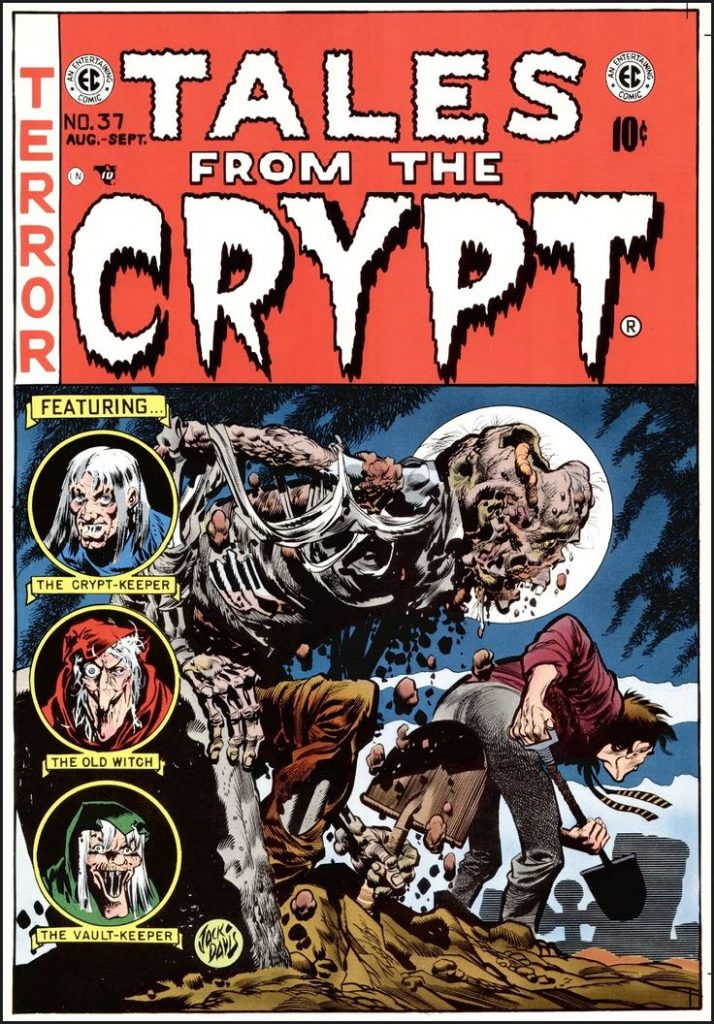
37(August, 1953). EC Comics.
PT: So, in a way, you were kind of an ‘outdated’ kid, you chose to read and collect those old comics instead of mainstream comics. Why that fascination with EC and all the rest? Was there any particular artist that you liked?
MD: I suppose that I was attracted to the old comics rather than the new mainstream comic books because I saw that the old ones were more extreme, they were made before the comic book code was introduced. That is what killed the horror comic book industry. I liked the EC artists like Jack Davis. I also liked the work of [Bill] Elder in the horror titles and MAD (the early EC comic book). There was a short lived one called Panic as well. Later on, I discovered the underground comics and felt they were the next level into the extreme. I wanted to see and collect even more extreme, wild comics but couldn’t find them. I liked Heavy Metal Illustrated magazine. That was when I was 14, 15 years old. I ended up ordering every single back issue of Heavy Metal Illustrated since the first issue, they were cheap then. The only other magazines I was ever interested in were the old issues of Creepy and Eerie. These felt a bit like the old EC comics. Some of the same artists were hired to draw the comics. And, of course, I liked MAD magazine and Cracked magazine. And Fangoria, with all the bloody special effect photos inside.
PT: I’m interested in this ‘extreme’ concept you bring up. What did you exactly understand by ‘extreme’ back then? Do you still look for that in comics?
MD: As a youth, I considered extreme to be comics that ventured outside of the normal comic books. The pre-code horror comics were trying to be gross and intense because that’s what its audience wanted, the more twisted the better. The underground comics were adult in nature with nudity and sex and violence that you would never find in mainstream comic books at the time. So, I liked the comics that made me think, ‘wow, that’s sick‘, or ‘that’s sexy‘. Not the kind of subjects you would find in a Richie Rich comic. So I wanted my own comics I drew to be edgy.
“I liked the comics that made me think, ‘wow, that’s sick‘, or ‘that’s sexy‘. Not the kind of subjects you would find in a Richie Rich comic”
PT: Let’s talk about your beginnings as a comic artist. When did you decide to start making your own comics and how was that experience? Did you start alone, or with friends?
MD: Well I was really young when I got into art. I liked crafts in nursery school, art class in grade school and rest of school years. I first liked newspaper comics, I would use silly putty to take the color Sunday comics image (you press the putty on the comic in newspapers). I later got into ugly stickers and horror head tattoos and started to draw my own monsters. I asked my mom and dad to send my drawings to the sticker company so they could print them. They got all weird like they didn’t know how to break the news to me that they would not use them. But I think it would have been cool if they sent them to Topps so they could see they influenced a kid.
I suppose my drawings turned into stories when I was maybe 9 years old. I started to draw my own characters, and put them in stories in comic form. One was Electoman, he was a giant and would fight giant monsters. He was just a giant rip-off of Ultraman that I would watch on TV at the time. Each morning before school I would watch it and my best friend would watch it and we would talk about it in school. A year later I came up with my character, Corky. He was a cork and had pins for arms and legs. He was magically alive and had friends, such as Springy and Drippy and a girl named Fleshy.
The storyline itself was on the innocent side compared to what was ahead. In high school, I started drawing comics that were nasty, vile, like a cat and mouse that would massacre each other and kill others. These ended up getting passed around the class and students would giggle and laugh and comment, “That’s so wrong!” I kinda had two big guys on the wrestling team become diehard fans of my now daily comic strips. They would laugh and then say, “Make sure you have something good tomorrow”.
One time I called a character in a comic Ed forgetting that one of wrestlers’ names was Ed. He kept saying, “I don’t know about that name Ed”, so I quickly put a letter N before each mention of the name Ed. Then he read it again and had a good laugh.
By my graduation year in 1987 I was drawing a comic in class that I wanted to print someday. It was called Marty the Mutant. So, after graduation, my best friend Robert, who is still a friend, he got a job at a print shop and the owner allowed us to use the machine to print our own book if we paid for the paper and did the work ourselves, so we started work on a book.
We shared our hatred of Florida, so we were allowed to just pay for paper and ink and do the work ourselves of printing the zine. It was a big printing press with aluminum plates you put on to print. We each drew comics and we could not decide on a title. I was into the extreme side and he was more into the exotic werewolf story he was doing. So, on my wall I had some old stickers framed, they were called Nutty Initials, monsters bent into letters. I put them in the frame in no order. So he said, “How about we call it that? HVUYIM”. So that’s what we called it.
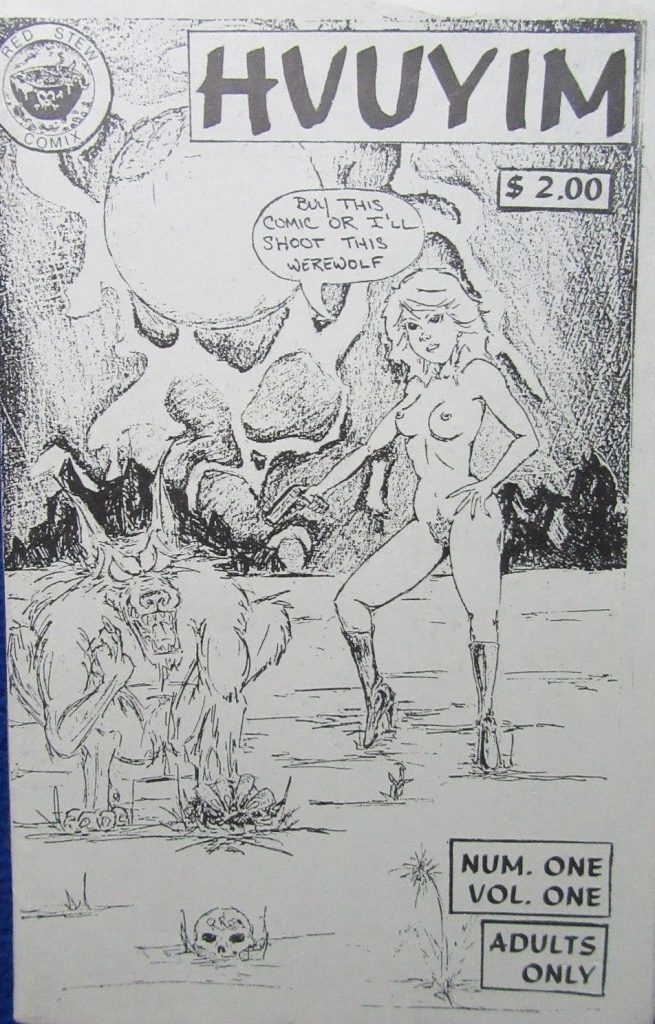
I believe we did 1,000 copies but after misprints not more than 900 were made. They are still out there so if you ever come across one you have a rare piece on your hands. In 1988, I put an ad out in Fangoria magazine, a classified ad. It got us one or two customers only. After that in 1988 I self-published my three issues of Angelfuck, and then in ’89 started the Boiled Angel series.
PT: Something like Angelfuck or Boiled Angel sounds like a statement. I mean, classic horror comics would not venture that far, especially into religious stuff. But you were titling your comics like that in a very conservative place and era, with the Reagan/Bush administration, the whole Parental Advisory movement, the televangelists and the neocons… Were you aware of that context? Was it on purpose? And how did that translate into your comics aesthetically speaking?
MD: Yes! That time period was happening for sure. I may have mentioned that at the time slasher horror films were the new rage still, and lots of cheap Friday the 13th copycat movies came out. The ratings board would butcher the gore scenes out. I guess it’s ok for them to watch those scenes but they have to save the horror fans from too much blood. Also, the parental stickers on the music and comedy albums became normal. When the 2 Live Crew album came out the governor of Florida at that time [Bob Martínez] made it illegal for record shops to sell it. They could have it on the shelf but couldn’t sell it. So undercover officers would go into the Turtles or Peaches record store and arrest the store clerk who was behind the counter for selling it. It’s such deep bullshit that as a person and artist I could not ignore. Like I could not ignore all the nightly reports of priests molesting children.

I saw firsthand how people were so afraid of being murdered by a serial killer that they would practically walk into the path of a bus and just die that way. I was forced to go to church so naturally I wanted to rebel. I started to add anti-religious themes to my zines. I did three Angelfuck issues. This title I got from a song by the band Misfits, it was such a rude word! Then I came up with Boiled Angel, thinking of a holy angel boiling in a soup being made by a big ugly devil, hee hee…My mom would want me to draw ‘nice’ things but that was no fun to me.
“The ratings board would butcher the gore scenes out. Also, the parental stickers on the music and comedy albums became normal. It’s such deep bullshit that as a person and artist I could not ignore”
PT: Well that must have been subversive and disturbing. They did fire you from the school you were working in, didn’t they? So how was that process, starting with Angelfuck and then Boiled Angel, losing your job amidst that repressive context? Did you feel more comfortable working alone?
MD: To put it in context, I had been working at Winn Dixie supermarket in high school for a minimum wage that was $3.35 an hour in 1986. I graduated in ’87, so then being 18 and having saved up to buy my car I got a job with the school board. My mom was a secretary in the building where they decided what text books to use and all that stuff. I started that job as a maintenance person, a janitor is what I was: empty the trash cans in offices, clean rest rooms, vacuum carpets. I worked from 3 pm till 11 pm and was getting $6.45 per hour. So I would do all my work very fast and then have hours to spend doing my comics.
Many of the Angelfuck and Boiled Angel drawings were done on work time at that job. I thought of it as getting paid for doing my art. Then I would make copies on the machine in the copy room. They had all different colors of paper, so no pages were white in those early issues. After three issues of Angelfuck I changed to digest size format, and changed title to Boiled Angel (these I also printed on the job). I then had bad luck with Boiled Angel Nr. 6: a secretary working late came in to make copies and saw me, she assumed I was helping my mom. I said I was but she got a glance at a copy I made of one of my sick drawings. Later, I was making the copies of that issue’s back cover and the paper got jammed in the machine. It was a new machine and I couldn’t find the key to open the copy machine door; I thought about breaking the lock but didn’t, I left the paper jam in hopes that the next morning the copy room secretary would just clear the jam and not pay attention to what it was but no, she contacted the campus police (like a special police force for the schools). The big problem was that about $10,000 in new computers had been stolen, and since they had no suspects they were asking me if I did it. They said I had to quit my job or get fired. I quit to keep my unused vacation pay that I would lose if fired, about $800.
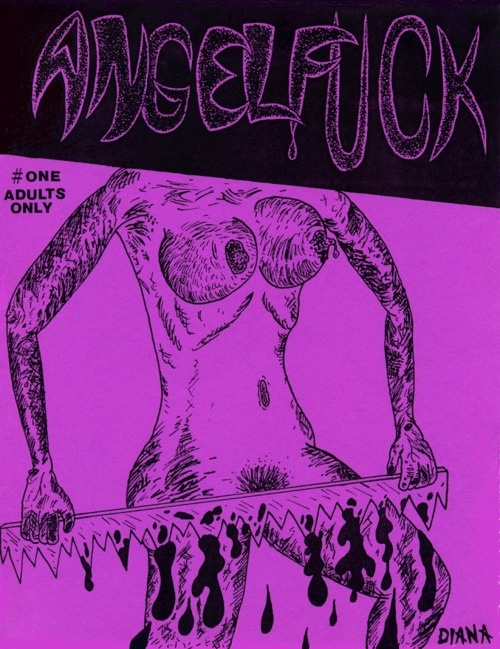
But at the last moment I decided I wanted to try and fight to keep my job, I went to the school review board and when the campus pigs saw me there they retaliated by having me charged with trespassing. So that was end of that job. Now you see how in my mother’s view my morbid zine caused me to lose my job, and to be questioned by the police for murder. Moms normally don’t like that shit, even if they support the act of making art. These days my mom embraces the weird stuff, like skull t-shirts and mildly strange stuff; these things are more infused with the mainstream nowadays.
After that, in 1991 with Boiled Angel Nr. 7, I met a girl by mail, she was a nail art girl in Colorado. I spent a couple summers there staying with her. I just didn’t work, slowly spending the money I had saved up (a little over $11,000).
I didn’t work for about 3 years, taking trips. She came to Florida a few times and we did road trips to gator farms on the way to Miami, looking at the giant Confederate flags out of the window along the roadside. We took road trips across the west, where we went to an amazing place called Garden of Eden in Lucas, Kansas. There was a man there who had built a tower in stone in the 1930s, with statues around his house, in a normal small neighborhood. He built his own mausoleum and stone coffin in his back yard and he was put in it when he died with a glass lid. The house tour was free but if you were to see his body in its coffin you had to pay a quarter. It was worth 25 cents for sure.
After that, in 1993, my dad bought a fruit stand and started selling beer and cigarettes so he could make money, so I was working for him there behind the cash register for $5 per hour plus a place to stay.
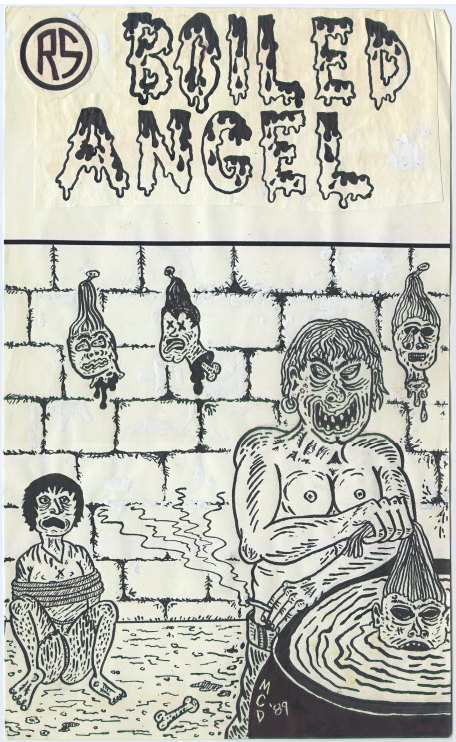
“A janitor is what I was. Many of the Angelfuck and Boiled Angel drawings were done on work time at that job. I thought of it as getting paid for doing my art”
PT: That sounds fascinating, even Kerouac-esque: a trip to the US southern core… How did all of that experience affect your comics? And during this time, did you get to know other comic artists? Were you in touch with different artistic scenes?
MD: Well I did know some comic artists from New York City. Scott Cunningham and Steven Cerio were both in NYC and I met them by mail with Boiled Angel, and met them in person when visiting NYC in 1992. I met Danny Hellman and Tony Millionaire, Dame Darcy was also in New York at that time. I pretty much was a loner and other than doing the mail, trading zines and having pen pals. I did not meet people. It was seldom that I would get visitors where I was in Florida. Not my crowd anyway.
I did a lot of video tape trades around 1991 thru like ’93 and one guy sent me old bestiality films like from the 1970s. I was in touch with a couple from France who were doing a zine review newsletter and they reviewed Boiled Angel. I must have mentioned in a letter I had the film with girl and a dog and they were into the extreme stuff and had never seen one of these films. They were much more excited about it than I was, I just felt, “it’s ok, nothing special”. They were visiting Disney World and since I was in Largo, about two hours from Orlando, they came to visit me.
I had mentioned to my Dad – both me and my brother lived with him -, that friends from France were stopping by to visit. So, when I met with them, we went to get a twelve pack of beer. We went back to my room and we each cracked open a beer, started watching the film. On the screen there was a close up of girl sucking a dog’s dick and me and this French guy and his wife sitting on my bed watching. So, dad comes in to say hi to them, glances at the TV screen and then looks at me and sees I was drinking a beer. He shook their hands and said “glad to meet you”, then said to me as he left my room “Can I see you outside a minute?” So when I went out he said “You know I don’t like you drinking beer!” [laughs] He didn’t say anything about the dog dick, I’m glad he didn’t, probably just told himself he didn’t see it.
I did do a performance piece once in ’92, in a small artist college type town called Melbourne (Florida). Someone had a band and asked me to do something as they played. I had a hood on my head, an old money sack; made holes for eyes. I got the largest dildo I could find at an adult sex shop, then turned it into a strap-on dick with one of my old belts. Then I got an old baby doll and yanked out the stuffing and was screwing it with the big cock. I had a plastic bag of heavy cream and when the music reached climax, I broke the bag so cream would pour out of the baby dolls head holes. The small crowd of perhaps 20 didn’t seem impressed.
As far as my art, my comics were being inspired by Florida road trips and the places you find, I have a comic called Tiki Gardens, named after a real place that was along the beach in Indian Rocks. Our family would stop there. It had grand gardens with giant Tiki heads (the gift shop sold Tiki heads and all that). They had a monkey named Diana in a cage; I saw it had a massive hard dick, I thought then it was a boy but many years later I would learn that the females’ clit looks like that when they are in heat. By the time I was in my mid-teens the Tiki Gardens was torn down. Now only a beach access parking lot remains, with the same name. I would travel to different gator farms. One comic I did is called Gator Bait. Takes place in a gator farm theme park.
I did a one-page comic in color called Murder at the Cypress Knee Museum, I went to the real life place, in Palmdale (FL). There, a man started a museum on his property of cypress knees he collected in the swamp. If they looked like something to him he would label them and add them to the many display cases. One was called frog boy because it looked like a frog with bulging eyes. Another was a perfect tall cone titled “KKK”. The man had passed away and his son was running it. There was lots of inspiration in those places for me.
“My comics were being inspired by Florida road trips and the places you find, I have a comic called Tiki Gardens. It had grand gardens with giant Tiki heads. I would travel to different gator farms. There was lots of inspiration in those places for me”






